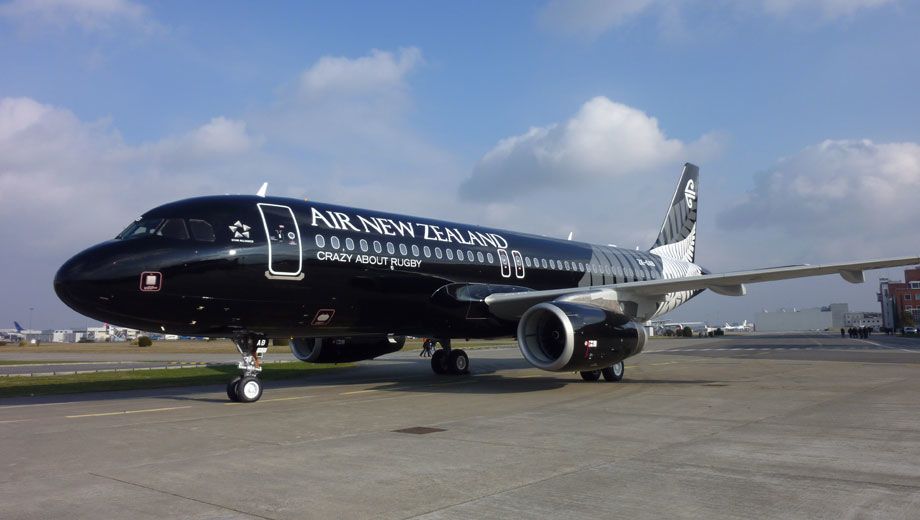Air New Zealand to offer in-flight mobile phone calls, texts and data next month

Air New Zealand passengers will be able to use mobile phones on selected domestic flights by the end of this month as the Kiwi flag-carrier trials in-flight wireless in two of its new Airbus A320 aircraft.
The first of these A320s -– complete with an eye-catching "Crazy About Rugby" all-black paint job in honour of the New Zealand rugby team -- took to the skies today, with a second more sedately-painted A320 "due to enter service later this month" according to an Air New Zealand spokeswoman.
Both are fitted with a 'picocell' which will allow passengers to use their mobile phones to send and receive calls and SMS messages. Smartphones like the iPhone and BlackBerry, along with 3G-enabled devices like iPads and laptops, will also be able to access the Internet do do email, browse the Web and post the inevitable updates to Twitter and Facebook.
That cell-in-the-sky won't be switched on until closer to the end of this month, so you have a few weeks of guaranteed silence before the person next to you starts yapping away throughout the whole flight.
But it probably won't come to that: the prices are literally sky-high and the service will initially be restricted to customers of Vodafone New Zealand.
On top of that the service will only be switched on during the level flight or 'cruise' section of the journey. And with Auckland-Wellington and Wellington-Christchurch flights taking only 45 minutes to begin with that's about 30 minutes of reception.
How much will it cost? Plenty!
- NZ 80c for each outgoing text (61c Australian)
- NZ$3.50 per minute for an outgoing call (AU$2.65)
- NZ$2 for an incoming call (AU$1.52)
- NZ$20 per megabyte of data (AU$15.16)
Yes, that's twenty NZ dollars per MB -- which works out at a staggering NZ$20,000 or AU$15,160 per gigabyte of data. So make sure that you've switched your Vodafone NZ cellphone all the way off to avoid a surprise roaming bill.
There's no word yet from other NZ providers Telecom or 2degrees about their roaming pricing on Vodafone's network, nor from Vodafone on pricing for non-NZ customers.
At some point after the service has been trialled on both aircraft Air New Zealand "will then evaluate demand for the service before making a decision on (upgrading) the rest of the fleet" a spokesperson told Australian Business Traveller.
The bulk of Air New Zealand's A320s serve trans-Tasman routes along with some very high demand internal flights, and a total of 14 factory fresh Airbus A320s will slowly replace Air NZ's domestic fleet of elderly 737-300s over the next five years.
In-flight telephony isn't exactly new, of course; it has been around since 1984, when Airfone introduced in-seat handsets. At rates of $6 to $10 per minute, and only voice (and sometimes SMS) functionality, they've dwindled in popularity over the last decade, as people have become accustomed to cheap mobile telephony on the ground, and data access wherever they go.
Qantas trialled a single domestic 767 aircraft a couple of years ago, using onboard mobile phone picocells -- essentially tiny, low power mobile phone base stations. The system was provided by Norwegian firm Aeromobile.
Passengers' phones could connect to the base stations at a very low power for GPRS data communication and SMS, rather than the high power they'd have to use while attempting to communicate with ground base stations. The pricing for the service was at global roaming rates for the Qantas flying "country", even though the plane never left Australia.
ACMA gave this sort of inflight mobile telephony system the green-light for broader implementation in July this year, but it was met by strong protest from Telstra, which said it would restrict passengers to using one provider and cost passengers more than it need to.
Telstra said Australian mobile networks were already capable of handling communication with passengers on planes. It suggested airlines should simply provide a link between the plane and the ground, allowing passengers to use their existing mobile network, with the airline charging a flat fee of $10 or $15 per flight.
"Australia has a thriving and highly competitive mobile market and there is no reason why it shouldn't extend to the skies as well," Telstra said in a submission to ACMA. It asked Qantas and other airlines to a round-table discussion with Telstra, and there has been very little by way of public comment from any party since.
Hi Guest, join in the discussion on Air New Zealand to offer in-flight mobile phone calls, texts and data next month